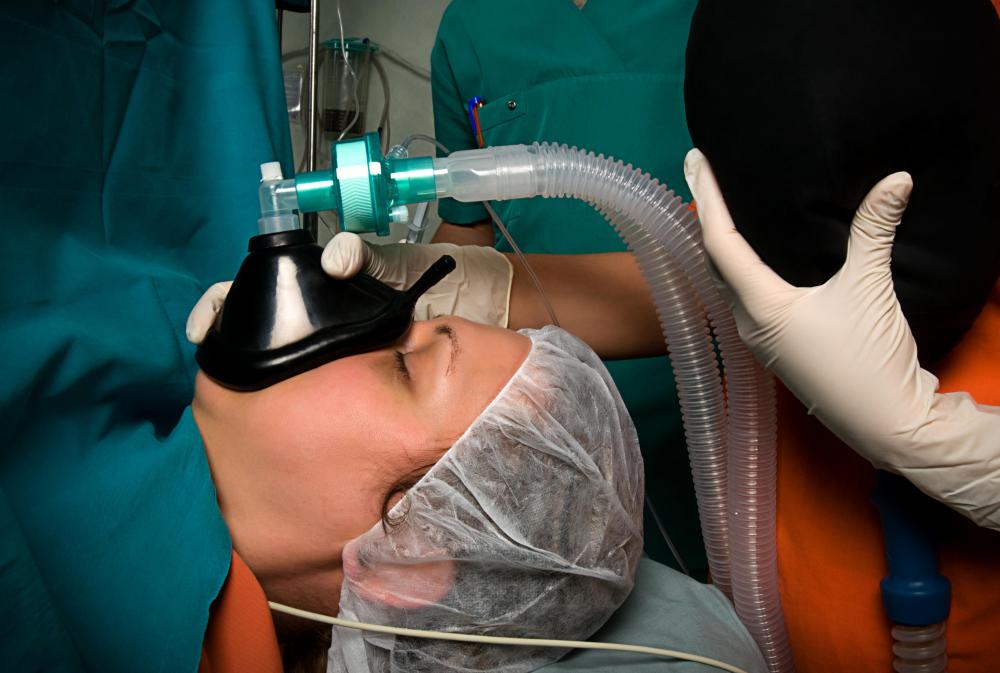At TheHealthBoard, we're committed to delivering accurate, trustworthy information. Our expert-authored content is rigorously fact-checked and sourced from credible authorities. Discover how we uphold the highest standards in providing you with reliable knowledge.
What is Foreskin Removal?
Foreskin removal is the surgical amputation of the male prepuce. This process is often called circumcision, particularly when performed for non-urgent purposes at birth or ritualistically later in life. Reasons why males undergo foreskin removal include religious, medical, military, and sanitary rationales, though there are many personal reasons why men are circumcised.
In the United States and many other countries, infant foreskin removal is usually performed under local anesthesia, while older males are usually given general anesthesia with the surgery performed while the patient is asleep. It is not obligatory that adults and older males be put to sleep for the procedure, as it can easily be performed under local anesthetic. Adults do typically have a longer recovery time and a more complicated foreskin removal surgery than infants, usually requiring stitches and taking around three weeks to heal. Men must be sure to abstain from erections of any origin and also to limit contact with the penis. Infants heal in five to ten days, requiring no special abstentions.

While adult foreskin removal is usually performed using only surgical tools and thus requiring stitches, there are specially designed devices used for hospital circumcisions of infants. These devices clamp down on the skin cutting off blood flow to the foreskin, and some remain on the penis until the wound has completely healed. Designed to prevent accidents in the detailed foreskin removal process, such as severing the infant's penis, these devices are usually used in conjunction with a restraining board to which the infant is strapped to limit movement.

In religious ceremonies, the procedure is much the same, particularly in countries with readily available medical equipment to be used. Even in areas without these benefits, the procedure is still typically performed by a community specialist who is generally responsible for the procedure for more than just one male over his or her career as circumciser. Exact amounts of foreskin removed may vary, some leaving part of the foreskin attached. In some traditions, the foreskin is ritually eaten or buried. Removed foreskins may also be used for skin grafts or medical research.

There are conflicting reports about the medical advantages of foreskin removal surgeries. Arguments have been made that removing the foreskin makes the penis more sanitary, which is often refuted by anti-circumcision activists by demonstrating that with proper cleaning there is no difference. Reports claiming that the surgery reduces risks of HIV have also been contested, some going so far as to argue the opposite case. The same claims have been made for other sexually transmitted diseases, with equally convincing arguments refuting those claims. Questions of medical benefits are often tied up in concerns over when the surgery is best implemented, as it is often performed on infants even though the majority of purported benefits would not be relevant until the boy reaches sexual maturity.

Almost all anti-circumcision advocates argue against the circumcision of infants and minors, as well as legally or medically mandated circumcision of males in general, but not against circumcision chosen freely by consenting adults. Whether the surgery is good or bad for the body, the question of whether a parent or institution has the right to elect for a child to have surgery that is not medically necessary is an ethical concern.

The most clear common ground between the two sides is that it is easy to perform foreskin removal on an adult but impossible to reverse it when performed on a child who later despises that this choice was made on his behalf. Medical, social, and ethical opinions on this topic continue to develop as conventional wisdom is questioned, often leading to changes in policy and cultural practice.
AS FEATURED ON:
AS FEATURED ON:
















Discussion Comments
I don't believe anything that anti circ people say, especially all that stuff about mutilation and pain caused to infants because of circumcision. Adults have more pain and complications than infants from circumcision.
I was circumcised as a sexually active young adult, and have experienced no issues either from the circumcision, no pain or infection, nor many years later. Sexually there is no difference.
My foreskin was normal, it was retractable when flaccid, and when erect it fully retracted and did not cover the glans. The problems came from the smell, a horrid smell that washing daily did not remove, a soft, moist, spongy glans which I did not like and the fact the foreskin collected fluff and hairs. Also my glans was always covered in a film of urine. Also I had PPP, but the papules disappeared after circumcision.
As for infant circumcision, I am indifferent. Parents do a lot of things which in retrospect are wrong and against individual choice. Like religious affiliation, ethnic identity, and so on. No one is against those issues.
I don't have a problem with retracting the foreskin and cleaning; it is quick under the showerhead. With phimosis it is difficult or impossible, depending on the degree. I stretched my phimotic band fairly quickly, since the degree of phimosis was small. I would rather keep the foreskin and am glad neither my parents nor I chose circumcision. Circumcision should be for the adult to choose, not parents or custom. Although the glans is extremely sensitive, so is the phimotic band and I can see no reason to remove it if it is correctly developed. Keeping the glans covered by the foreskin protects the glans and may preserve sensitivity. I read somewhere that rubbing of the glans against clothing, apart from promoting erection, can cause thickening of the skin and lowered sensitivity. Removing the foreskin of a baby should be illegal.
My parents decided against surgical foreskin removal, mostly because they were concerned about traumatizing their child so soon after birth. I've had time to consider the circumcised vs uncircumcised arguments, and I'd have to say that being uncircumcised works better for me personally. I may have to take a few more minutes during my personal bathing and grooming routine, but it's not as bad as some pro-circumcision people make it out to be.
I agree that circumcision shouldn't be a default setting for male babies born in hospitals. I can understand the religious angle, but I'm also concerned about the qualifications of a non-medical professional performing any kind of surgery like that on babies.
I read somewhere that scientists attached some sort of pain meter on male babies just before foreskin removal surgery, and the pain level was extremely high. I'd always been told that the surgical removal of the foreskin was relatively painless, but it looks like that's not the case. According to those results, it can be one of the most painful experiences a male can face.
I was circumcised surgically, mostly because that was the standard practice at that time. Baby boys were routinely circumcised a few days after birth. I'm not bothered by that fact, because I do believe a circumcised penis is easier to keep clean. But I sometimes wish that decision could be left up to the adolescent or adult male instead of just going ahead and doing it to a small baby.
Post your comments